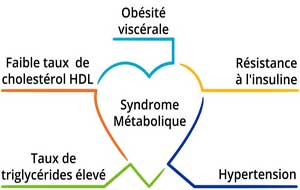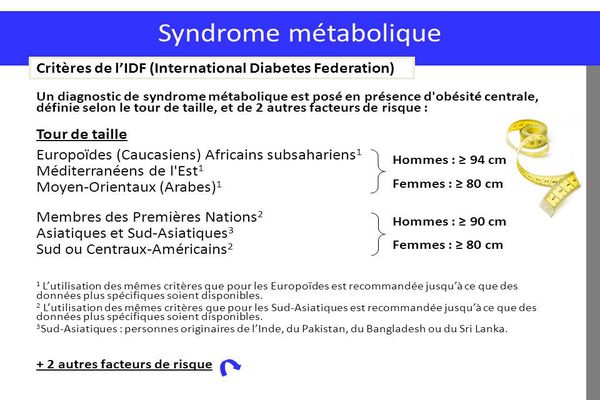What is metabolic syndrome? How can it be prevented and treated naturally?
![]()
 Metabolic syndrome may not be a disease, but it’s more than just the fact that your metabolism has become slow or unbalanced. In fact, it’s a health condition that results from a combination of several physiological and biochemical disorders.
Metabolic syndrome may not be a disease, but it’s more than just the fact that your metabolism has become slow or unbalanced. In fact, it’s a health condition that results from a combination of several physiological and biochemical disorders.
The term “metabolic” refers to the biochemical processes involved in the normal functioning of the body.
When you have metabolic syndrome, your body is not functioning normally. Worse, metabolic syndrome increases the risk of very worrying and potentially fatal health problems, including heart disease, stroke and diabetes.
However, there are many ways to avoid metabolic syndrome, such as maintaining a healthy weight, getting regular exercise and adopting a diet free from foods that can harm your metabolism. There’s even a metabolic syndrome diet and natural treatment plans to restore your metabolic function.
What is metabolic syndrome?
Also known as “syndrome X”, metabolic syndrome refers to the coexistence of several health disorders of lipid, carbohydrate or vascular origin associated with excess weight, in the same individual.
It refers to a group of conditions including abdominal obesity, elevated triglycerides, elevated fasting blood glucose, hypertension or low HDL cholesterol.
When a person has three or more of these metabolic risk factors, it’s called metabolic syndrome.
Around 85% of people with type 2 diabetes have metabolic syndrome, and are at much greater risk of heart disease than the 15% of people with type 2 diabetes without metabolic syndrome. [1].
Symptoms and risk factors
Unfortunately, most disorders associated with metabolic syndrome are asymptomatic.
However, one of the most frequent visible signs is a large waist circumference: at least 102 cm for men and 88 cm for women.
For men, a normal waist circumference is less than 94 cm, while the threshold for obesity starts at 102 cm.
For women, the norm is minus 80 cm, and the obesity threshold is equal to or greater than 88 cm.
If most of your fat is around your waist rather than your hips, you run a higher risk of heart disease and type 2 diabetes. [2].

Other symptoms and risk factors of metabolic syndrome include:
1. High fasting blood sugar
If your blood sugar is very high, you may experience signs and symptoms of diabetes such as increased thirst, increased urination, fatigue and blurred vision.
A normal fasting blood glucose level is less than 1 g/L. Between 1 and 1.25 g/ L is considered prediabetes. And a fasting blood glucose level of 1.26 g/L or more is considered diabetes.
A fasting blood glucose level of 1 g / L or more (or the use of medication to treat hyperglycemia) is considered a metabolic risk factor.
2. Hypertension
High blood pressure is another symptom and risk factor of metabolic syndrome, which can go unnoticed unless you check your blood pressure regularly.
A blood pressure of 130/85 mmHg or higher (or the use of blood pressure medication) is considered a metabolic risk factor.
3. High triglycerides
Elevated triglycerides are another possible sign of metabolic syndrome.
Triglycerides are a type of fat or lipid found in the blood. When you eat, your body immediately converts calories it doesn’t need into triglycerides.
A triglyceride level of 1.5 g/L or higher (or taking medication to treat high triglycerides) is a metabolic risk factor.
4. Low HDL cholesterol
HDL cholesterol is often called “good” cholesterol, because it helps remove cholesterol from your arteries.
An HDL cholesterol level of less than 0.5 g/L in women and less than 0.4 g/L in men (or the use of anti-HDL cholesterol medication) is a risk factor for metabolic syndrome.
A physician can diagnose metabolic syndrome based on the results of a physical examination and blood tests.
Here’s an illustration to summarize the symptoms of metabolic syndrome

Causes of metabolic syndrome
The two main causes of metabolic syndrome are overweight or obesity and lack of physical activity.
Researchers conducted a study in 2017 to determine the effect of resistance exercise, alone and in combination with cardio exercise, on the risk of developing metabolic syndrome.
The observed results highlighted that one hour of weekly resistance exercise was associated with a 29% reduction in the risk of developing metabolic syndrome, compared with no physical activity.
Participants who added cardio exercise to their resistance exercise had a 25% lower risk. [3].
Metabolic syndrome is also a metabolic disease directly linked to insulin resistance, a health condition more common in obese and inactive people.
What is insulin resistance?
Normally, a healthy digestive system breaks down food into glucose for use as fuel.
Insulin, a hormone produced by the pancreas, contributes to this process by facilitating the penetration of glucose into cells.
Insulin resistance means that cells do not respond in the typical way to insulin, and so glucose cannot penetrate cells as easily.
This causes blood glucose levels to rise, despite the body’s efforts to manage the situation by producing more and more insulin.
If this situation persists, over time the body will be unable to produce enough insulin to maintain blood glucose levels within the normal range, leading inevitably to diabetes. And since almost 85% of people with type 2 diabetes also have metabolic syndrome, if you develop diabetes, your risk of developing metabolic syndrome will be very high.
Other risk factors
Additional risk factors, most of which are unfortunately beyond your control, that are likely to increase your risk of developing metabolic syndrome include:
- Age: The risk of metabolic syndrome increases with age. It affects 40% of people over 60;
- Race: Latinos and Asians appear to be at greater risk of metabolic syndrome than other races;
- Family history of diabetes: You are more likely to have metabolic syndrome if you have a family history of type 2 diabetes, or if you had diabetes during pregnancy (gestational diabetes) ;
- Other diseases: Your risk of metabolic syndrome is higher if you’ve ever had cardiovascular disease, non-alcoholic fatty liver disease or polycystic ovary syndrome.
Gallstones and breathing problems during sleep (such as sleep apnea) are also suspected risk factors for metabolic syndrome.
Metabolic syndrome diet
– Foods to avoid
1. Processed and “fake” foods
As far as possible, avoid processed foods and “fake foods” or ultra-processed foods that are designed entirely by agri-food industrialists. These products are generally devoid of nutrients and contain unhealthy additives and preservatives.
In fact, a 2015 study revealed that fast-food consumption increases the incidence of metabolic syndrome in both children and adults [4].
In addition, Brazilian researchers found that high consumption of ultra-processed foods was associated with metabolic syndrome in adolescents [5].
2. Artificial sweeteners
Artificial sweeteners have been directly linked to the onset of diabetes and metabolic syndrome. Accumulating evidence suggests that frequent consumption of sugar substitutes containing aspartame, sucralose and saccharin increases the risk of excessive weight gain, as well as the development of metabolic syndrome, type 2 diabetes and cardiovascular disease. [6].
3. Soft drinks
Studies show that soda consumption is associated with significantly higher risks of certain components of incident metabolic syndrome and type 2 diabetes.
According to a 2009 study, daily soda consumption increased the risk of metabolic syndrome by 36% and type 2 diabetes by 67%! [7].
4. Trans fats or trans fatty acids
Trans fats are found in foods based on hydrogenated oils and fats, such as margarine; bakery products such as cookies, cakes and pies; crackers; ice cubes and coffee cream.
These trans fats raise LDL (bad) cholesterol and triglyceride levels.
This increase can have a negative impact on your waistline, heart health and metabolic disorders. [8].
5. Refined carbohydrates and sugar
Consumption of these two products is the main cause of high blood sugar levels, insulin resistance and the development of diabetes and metabolic syndrome.
The sugar, especially when used to sweeten beverages, is one of the main culprits, as are refined carbohydrates. [9].
A recent study in Korea, where the incidence of metabolic syndrome is high, examined the effects of refined carbohydrates on this metabolic disorder.
The researchers found that “the percentage of energy from carbohydrates in men and the consumption of refined grains, including white rice, in women were associated with metabolic syndrome.” [10].
6. Alcohol
Too much alcohol can raise your blood pressure and triglyceride levels.
Alcohol also adds extra calories to your diet, which can lead to weight gain.
However, moderate alcohol consumption can be good for you. So says a meta-analysis published in Clinical Nutrition which showed that while excessive alcohol consumption increases the risk of metabolic syndrome, “very light alcohol consumption appeared to be associated with a reduced risk of metabolic syndrome” [11].
Men should consume no more than two glasses of alcohol per day, while women should consume no more than one alcoholic beverage per day.
One drink corresponds to :
- 33 cl beer ;
- 15 cl wine ;
- 4 cl liqueur.
– Foods that heal and prevent metabolic syndrome
Some of the most important foods for curing and preventing metabolic syndrome include:
1. Fish and omega-3
The omega-3 found in cold-water fish help regulate heart rate, lower blood pressure, reduce blood clot formation and reduce overall inflammation [12].
Omega-3-rich foods are also cholesterol-lowering foods, helping to reduce triglycerides and bad LDL cholesterol.
In addition to fish, other omega-3 foods include walnuts, flaxseed, natto and grass-fed beef.

2. Vegetables
Dark leafy vegetables such as kale and spinach, avocado, broccoli, cabbage and carrots are just some of the many dietary sources rich in antioxidants and anti-inflammatory phytonutrients.
Avocado consumption, in particular, has been shown to be clinically beneficial in preventing metabolic syndrome. [13].
3. Fruit
In moderation (so as not to overindulge in natural sugar), eating fruit every day is an easy and therapeutic habit to adopt.
Research has shown that pomegranate seeds in particular help improve metabolic syndrome. Studies published in Food & Nutrition have concluded that pomegranate “exerts hypoglycemic effects, including an increase in insulin sensitivity, inhibition of a-glucosidase and an impact on glucose transporter function 4. It is also responsible for a decrease in cholesterol across all lipid profiles, as well as anti-inflammatory effects through modulation of the respiratory pathways activated by peroxisome proliferators. These effects may also explain the role of pomegranate-derived compounds in ameliorating the adverse health effects caused by metabolic syndrome”.[14].
4. Legumes
Delicious legumes to try include kidney beans, lentils, chickpeas, black-eyed peas and lima beans. Rich in fiber and protein, legumes are an excellent daily choice for keeping your blood sugar stable and your waistline trim. They are particularly useful in preventing metabolic syndrome.
A 2014 study examined the effects of legumes on metabolic syndrome. A validated 48-item food frequency questionnaire was used to assess the dietary behaviors of 2027 people drawn from the Isfahan Healthy Heart. The researchers found that “all components of metabolic syndrome were less frequent in subjects with regular legume consumption.” [15].
5. Whole grains
Fiber-rich foods like whole grains, including rolled oats and brown rice, not only have proven benefits for diabetes and heart health, they also help control your waistline. As such, whole grains are part of a balanced and healthy treatment plan for metabolic syndrome.
– Supplements
1. Ginseng, berberine and bitter melon
Research published in 2009 showed that ginseng, berberine and bitter melon, commonly used in Chinese medicine, are powerful natural remedies for metabolic syndrome.
They help regulate glucose and lipid metabolism, which directly and positively affects weight management [16].

2. Holy basil / tulsi
Researchers at the Department of Home Science, Azad University of Agriculture and Technology, India, have studied the effects of holy basil leaves on blood sugar and serum cholesterol levels in humans in double-blind clinical trials.
The results showed that basil controlled blood sugar and brought about slight improvements in cholesterol levels.
These results suggest that basil supplementation may be a useful and safe way to help control diabetes and its complications, such as metabolic syndrome. [17].
3. Spirulina
Spirulina contains phycocyanin, a pigment with anti-hypertensive effects. In other words, it lowers blood pressure.
Japanese researchers claim that consumption of blue-green algae reverses endothelial dysfunction in metabolic syndrome. [18].

4. Maca root
Maca root increases glutathione levels in the body, which not only improves your immune system and resistance to disease, but also helps balance appropriate levels of cholesterol in the body.
In addition, it significantly improves glucose tolerance by lowering levels in the blood, improving heart health and conditions such as diabetes or metabolic syndrome. [19].

Natural treatment of metabolic syndrome
1. Essential oils
The best essential oils for weight loss are grapefruit, cinnamon and ginger.
Grapefruit essential oil works by activating enzymes that help your body break down brown body fat.

Cinnamon oil helps regulate blood sugar and FGT (glucose tolerance factor). For this reason, cinnamon oil is also effective for anyone with diabetes. [20, 21].

Ginger oil reduces sugar cravings and helps reduce inflammation in the body.
If you want to lose weight, it’s essential to reduce inflammation and aid digestion and nutrient absorption. Ginger oil helps you do just that. [22].

2. Burst workout
Getting rid of belly fat is the key to treating metabolic syndrome.
Burst training helps your body become a fat-burning machine.
This typical form of exercise involves alternating sessions of high-intensity exercise (90 to 100% of your maximum heart rate for 30 to 60 seconds) and rest/recovery periods of 30 to 60 seconds.
If conventional training hasn’t worked for you, it’s because long-distance cardiovascular exercise can decrease testosterone and increase the stress hormone cortisol.
Increased cortisol levels stimulate appetite, increase fat storage and slow or inhibit exercise recovery.
If burst training isn’t for you, aim for at least 30 minutes a day of moderate-intensity exercise, such as brisk walking [23].
3. Lose weight
Losing weight can reduce insulin resistance and blood pressure, helping to control your metabolic syndrome. [24].
4. Stop smoking
Smoking can lead to and worsen the health consequences of metabolic syndrome and increase the likelihood of heart problems and strokes, among other major health problems. [25].
Conventional treatment of metabolic syndrome
Changes in unhealthy habits (dietary and others such as sedentary lifestyle) are generally the main treatment for metabolic syndrome.
Recommended lifestyle changes generally include a heart-healthy diet, good stress management, losing and maintaining a healthy weight, regular physical activity and giving up unhealthy habits such as smoking.
If lifestyle changes aren’t effective, your doctor will probably prescribe medication to treat and control your risk factors, such as hypertension, high triglycerides, low HDL cholesterol and hyperglycemia.
A doctor’s primary goal in treating metabolic syndrome is to reduce the risk of coronary heart disease.
The second goal of treatment is to prevent the onset of type 2 diabetes, if it has not already developed.



